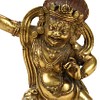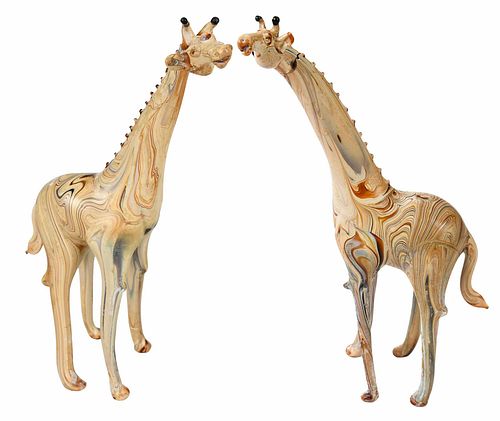Pair of Chinese Pulled Glass Giraffes
Bid Increments
| Price | Bid Increment |
|---|---|
| $0 | $25 |
| $100 | $50 |
| $1,000 | $100 |
| $2,000 | $200 |
| $3,000 | $250 |
| $5,000 | $500 |
| $10,000 | $1,000 |
| $20,000 | $2,000 |
| $50,000 | $5,000 |
| $100,000 | $10,000 |
each with caramel and cream marbled surface, pontil scars to undersides, 9-1/2 in.
Note: This pair was purchased from an Asian Antiquities gallery in New York known for their porcelain and bronze wares. In Chinese mythology, the ?Qilin? is a hooved chimerical beast, which is essentially a stylized avatar of the giraffe whose initial references date back to 5th century BC. It was considered as a good omen, associated with the inevitable rise to power or death of an eminent monarch or a sage. Moreover, according to Chinese feng shui, giraffe figurines stand as symbols of friendship. The material itself shows an unending swirl of natural colors. The Tang benefited from the foundations the Sui had laid, and they built a more enduring state on the political and governmental institutions the Sui emperors established. Known for its strong military power, successful diplomatic relationships, economic prosperity, and cosmopolitan culture, Tang China was, without doubt, one of the greatest empires in the medieval world. This confident cosmopolitanism is reflected in all the arts of Tang China. The constant exchange of goods along the Silk Road, such as textiles, metalwork, and glassware, inspired Tang craftsmen to experiment with novel techniques, shapes, and designs. (ref: Natn'l Museum of Asian Art)
Provenance: Private Collection, Colorado
Condition
one with break and repair to neck; one with break and repair to back leg
Purchased items will be available for pick up or shipping from our Asheville, North Carolina auction facility within ten business days of the auction will be assessed a storage fee of $5.00 per day, per item. Purchaser agrees that packing and shipping is done at the purchaser's risk and that the purchaser will pay in advance all packing expenses, materials, carrier fees and insurance charges. At our discretion, items will either be packed by an agent such as a packaging store or Brunk Auctions. Please allow two weeks for shipping after payment is received. Shipment of large items is the responsibility of the purchaser. We are happy to provide names of carriers and shippers if a purchaser so requests. Brunk Auctions will have no liability for any loss or damage to shipped items.











